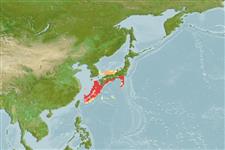Environment: milieu / climate zone / depth range / distribution range
Ecología
marino batidemersal; no migratorio; rango de profundidad 200 - 720 m (Ref. 1371). Deep-water; 37°N - 23°N, 124°E - 140°E (Ref. 1371)
Distribución
Países | Áreas FAO | Ecosistemas | Ocurrencias, apariciones | Point map | Introducciones | Faunafri
Northwest Pacific: southern Japan and the East China Sea. Recently recorded from northeastern Taiwan (Ref. 54421).
Tamaño / Peso / Age
Maturity: Lm ? range ? - ? cm
Max length : 21.0 cm TL macho / no sexado; (Ref. 1371)
Espinas dorsales (total): 2; Espinas anales 0. Snout short, blunt; terminal and lateral scutes large, blunt; undersides of snout, mandible, most of the suborbital, and part of the lower margin of the preopercle naked. Body scales with sharp, slender spinules in 4 to 16 parallel rows. Pyloric caeca 25 to 28. Overall color is brown; abdomen bluish; gill membranes blackish; fins dusky, first dorsal fin blackish distally; oral and branchial linings blackish.
Uncommon in depths shallower than 400 m. Frequents waters of 5-7°C. Polychaetes and euphausiids compose 30-60% of the diet of specimens from Japan, and prawns of minor importance.
Life cycle and mating behavior
Madurez | Reproducción | Puesta | Huevos | Fecundidad | Larva
Cohen, D.M., T. Inada, T. Iwamoto and N. Scialabba, 1990. FAO species catalogue. Vol. 10. Gadiform fishes of the world (Order Gadiformes). An annotated and illustrated catalogue of cods, hakes, grenadiers and other gadiform fishes known to date. FAO Fish. Synop. 125(10). Rome: FAO. 442 p. (Ref. 1371)
IUCN Red List Status (Ref. 130435)
Threat to humans
Harmless
Human uses
Pesquerías: escaso valor comercial
Más información
Nombres comunesSinónimosMetabolismoDespredadoresEcotoxicologíaReproducciónMadurezPuestaAgregación para la puestaFecundidadHuevosEgg development
ReferenciasAcuiculturaPerfil de acuiculturaRazasGenéticaElectrophoresesheritabilidadEnfermedadesProcesamientoNutrientsMass conversion
Herramientas
Special reports
Download XML
Fuentes de Internet
Estimates based on models
Preferred temperature (Ref.
123201): 8.6 - 15.7, mean 12.9 °C (based on 22 cells).
Phylogenetic diversity index (Ref.
82804): PD
50 = 0.5000 [Uniqueness, from 0.5 = low to 2.0 = high].
Bayesian length-weight: a=0.00219 (0.00111 - 0.00431), b=3.20 (3.03 - 3.37), in cm total length, based on LWR estimates for this (Sub)family-body shape (Ref.
93245).
Nivel trófico (Ref.
69278): 3.3 ±0.43 se; based on food items.
Resiliencia (Ref.
120179): Medio, población duplicada en un tiempo mínimo de 1.4-4.4 años (Preliminary K or Fecundity.).
Fishing Vulnerability (Ref.
59153): Low vulnerability (11 of 100).
